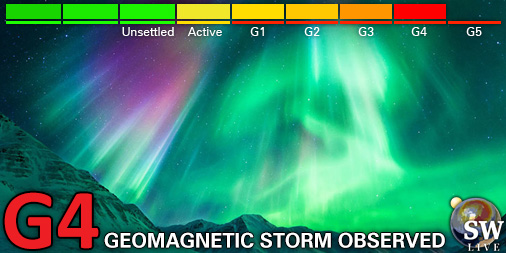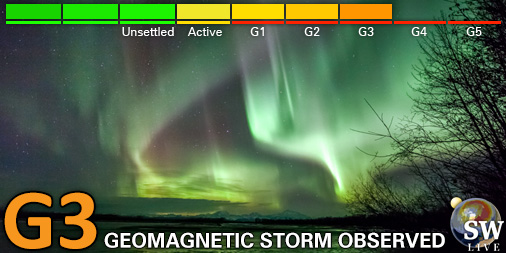Viewing archive of Wednesday, 7 November 2001
Solar activity report
Any mentioned solar flare in this report has a scaling factor applied by the Space Weather Prediction Center (SWPC). Because of the SWPC scaling factor, solar flares are reported as 42% smaller than for the science quality data. The scaling factor has been removed from our archived solar flare data to reflect the true physical units.
Report of Solar-Geophysical Activity 2001 Nov 07 2200 UTCPrepared by the NOAA © SWPC and processed by SpaceWeatherLive.com
Joint USAF/NOAA Report of Solar and Geophysical Activity
SDF Number 311 Issued at 2200Z on 07 Nov 2001IA. Analysis of Solar Active Regions and Activity from 06-2100Z to 07-2100Z
Activity increased to high levels. Region 9690 (S17E45)
produced an M5/1n flare at 07/2001 UTC associated with relatively
minor centimetric radio bursts. This region showed no significant
changes, but remained large and magnetically complex. It also
produced numerous flares including three low-level M-class. Region
9684 (N06W68) was stable as it approached the west limb, but
remained magnetically complex. Region 9687 (S20W02) also showed a
complex magnetic structure, but was quiet during the period. New
Regions 9691 (N07E64), 9692 (N07W10), 9693 (N11E03), and 9694
(N14E79) were numbered. Today's Penticton noon 10.7 cm radio flux
reading of 269 SFU was flare enhanced. The morning reading of 230
SFU was more reflective of the current state of the Sun.
IB. Solar Activity Forecast
Activity is expected to be at moderate
to high levels. M-class flares are expected. There will be a chance
for isolated major flare activity from Regions 9684, 9687, and 9690.
IIA. Geophysical Activity Summary 06-2100Z to 07-2100Z
Geomagnetic field activity ranged from unsettled to minor storm
levels through 07/0600 UTC, then decreased to mostly quiet to
unsettled levels for the remainder of the period as CME effects
subsided. The greater than 100 MeV proton event that began on 04
November ended at 06/2315 UTC. The greater than 10 MeV proton event
that began on 04 November continued. The polar cap absortion event
continued as well.
IIB. Geophysical Activity Forecast
Geomagnetic field activity is
expected to be at mostly quiet to unsettled levels with brief active
intervals possible during the first half of the period. The greater
than 10 MeV proton event is expected to end late on 09 November. The
polar cap absorption event is expected to end early on 09 November.
III. Event Probabilities 08 Nov to 10 Nov
| Class M | 80% | 80% | 75% |
| Class X | 25% | 25% | 20% |
| Proton | 99% | 90% | 30% |
| PCAF | in progress | ||
IV. Penticton 10.7 cm Flux
Observed 07 Nov 269 Predicted 08 Nov-10 Nov 230/230/220 90 Day Mean 07 Nov 208
V. Geomagnetic A Indices
Observed Afr/Ap 06 Nov 060/112 Estimated Afr/Ap 07 Nov 018/020 Predicted Afr/Ap 08 Nov-10 Nov 012/012-012/012-010/010
VI. Geomagnetic Activity Probabilities 08 Nov to 10 Nov
| A. Middle Latitudes | |||
|---|---|---|---|
| Active | 25% | 25% | 20% |
| Minor storm | 10% | 10% | 10% |
| Major-severe storm | 05% | 05% | 05% |
| B. High Latitudes | |||
|---|---|---|---|
| Active | 30% | 30% | 25% |
| Minor storm | 15% | 15% | 15% |
| Major-severe storm | 05% | 05% | 05% |
All times in UTC
Latest news
Latest forum messages
2025/04/12-13 Filament CMEs 2025/04/16 G3 Watch 467Coronal holes 49Filaments and prominences 67AR4064 9Incoming & Unnumbered Active Regions 1742
More topicsSupport SpaceWeatherLive.com!
A lot of people come to SpaceWeatherLive to follow the Sun's activity or if there is aurora to be seen, but with more traffic comes higher server costs. Consider a donation if you enjoy SpaceWeatherLive so we can keep the website online!

Latest alerts
Wednesday, 16 April 2025
21:45 UTC - Geomagnetic activity
Minor G1 geomagnetic storm (Kp5) Threshold Reached: 21:36 UTC
21:00 UTC - Geomagnetic activity
Severe G4 geomagnetic storm (Kp8) Threshold Reached: 20:55 UTC
19:45 UTC - Geomagnetic activity
Strong G3 geomagnetic storm (Kp7) Threshold Reached: 19:25 UTC
19:00 UTC - Geomagnetic activity
Moderate G2 geomagnetic storm (Kp6) Threshold Reached: 18:38 UTC
18:45 UTC - Geomagnetic activity
Minor G1 geomagnetic storm (Kp5) Threshold Reached: 18:28 UTC
Space weather facts
| Last X-flare | 2025/03/28 | X1.1 |
| Last M-flare | 2025/04/15 | M1.2 |
| Last geomagnetic storm | 2025/04/16 | Kp8- (G4) |
| Spotless days | |
|---|---|
| Last spotless day | 2022/06/08 |
| Monthly mean Sunspot Number | |
|---|---|
| March 2025 | 134.2 -20.4 |
| April 2025 | 124.1 -10.1 |
| Last 30 days | 122.5 -17.8 |







